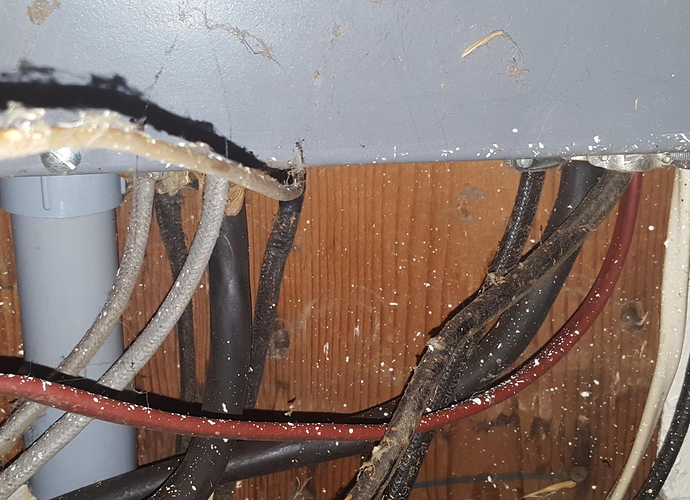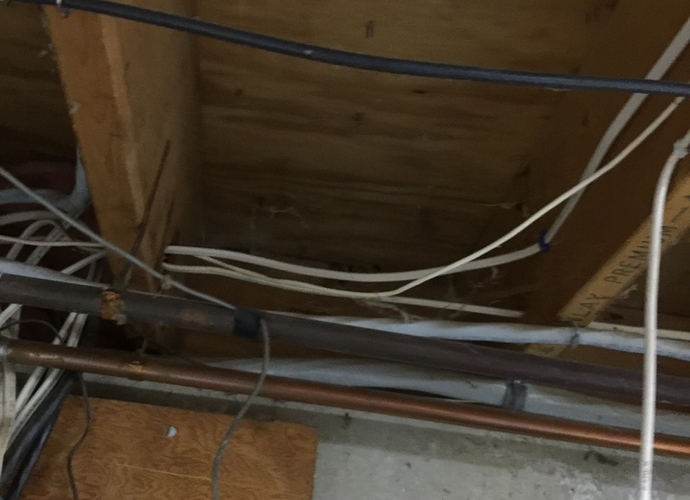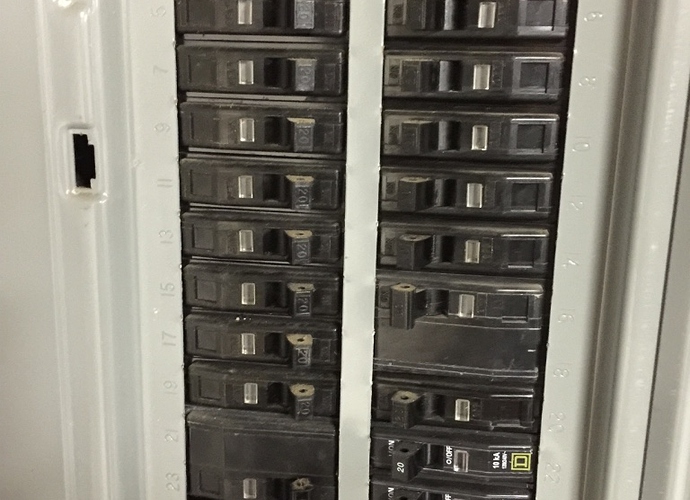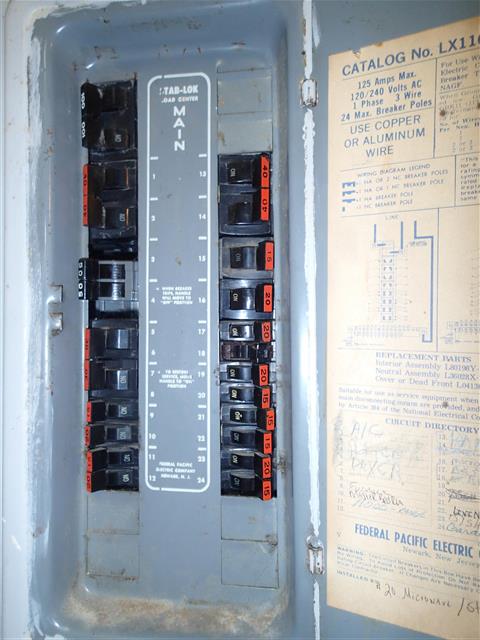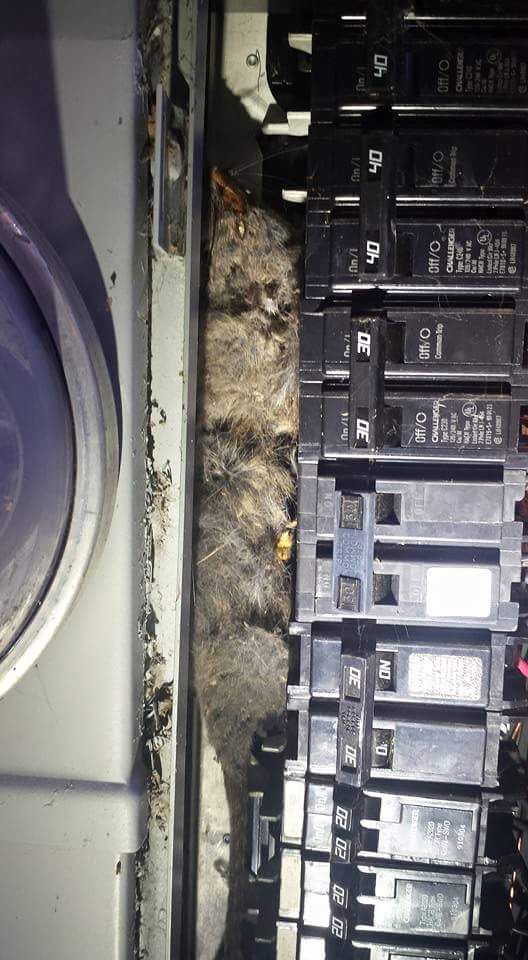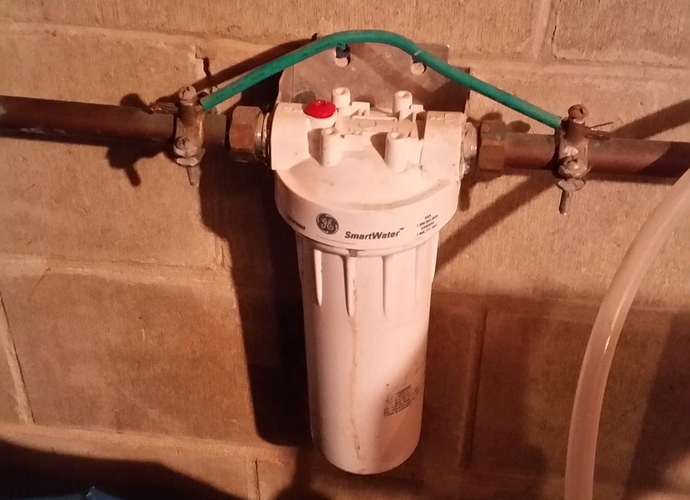I looked at this box the other day. I recommended that the homeowner have an electrician come look at changing it over and updating it. I noticed that it was the old fuses and that there was sufficient connectors but the load was heavy and they wanted to add a dishwasher.
I reviewed two articles for this module, “Electrical Service Panels” and “Electrical Terms”.
The first article was a good reminder and basic information on safety. It also was a good reminder as to what boxes I should look for that could be faulty.
The second article did a good job explaining terms commonly used. I found the descriptions to be well written. I also did not know it was “current that kills” not voltage.
I did not have property owner permission to open the panel, so I evaluated what I could from the outside. The panel is in the basement. The breakers are labeled. There were no missing knockouts. The wiring is properly supported and bored through the joists. The main disconnect is not located in this box. The 60 amp main disconnect is located in a square d box, on the outside of the house adjacent to the meter.
For this research essay I chose Electrical Terms and Electrical Service Safety because I have a strong background in construction, environmental, and safety, and I am weaker in my knowledge of electrical wiring. The article on Electrical Terms clearly defines the vocabulary necessary for electrical inspection and helps to clarify the relationship between energy, flow, and resistance and how they create safety issues. The article on Electrical Service Safety close tied to the material presented in the module. It presented common hazards in electrical inspection. It is particularly hazardous that rodents can enter panels and chew through the wiring. The hazards of arc flash are immense. The explosion of molten wiring can cause severe burns and death.

The main panel was located in the garage, it does not have proper clearance, it should have and area 30" wide and 36" deep for access during a emergency situation.
There was also areas of concern noted in the pictures one connection appeared to have been hot and scorched at some point and another appeared to have been hot and bubble the wire insulation.
Note as well that this a Federal Pacific Panel and breakers provided in this home there is a documented history of failures with these devices which presents a adverse condition for the home and it’s occupants.
This along with the other issues presented in the pictures recommended it should be further evaluated by a qualified electrical contractor.
7.6 Item 1(Picture)
Writing Assignment 1
After reading the article about electrical safety, I decided to look around my own house one more time.
As you can see, around and on top of the water heater is packed with junk. This is not safe at all. If the water heater was to has problem, I would be tripping over everything to get to it, and possible getting shocked trying to get to it.
Noted where the Main Panel Is.
I can thank My loving wife for being a Hoarder.
Writing Assignment 2
Electrical panel safety
Electrical panel safety, as you can also see in the Picture the absolutely NO room around the panel. the does not show the car that is normally park in front of it. So with the car parked there in front and all the other things stored between, it does not meet the open space requirements of 36 in front x 30 wide x 6 feet of head room. it will also take more then 6 steps to turn the Main Power off.
Oh Ya, I did I mention everything there is Combustible.

This panel is a subpanel located in the basement/garage area. It is fed from the main house panel located upstairs approximately 8 feet away. There are several items of concern with this panel that should be further investigated by a qualified electrician as follows :
-
Feed from upstairs main panel is via a parallel pair of AWG#10 wires allowing 60 amp capacity total. The main panel breaker feeding this is rated 50 amps. Effectively this subpanel is only capable of supporting a 50 amp maximum capacity.
-
The parallel AWG#10 conductors are double-tapped to the subpanel 100 amp breaker. Double tapped connections should be corrected and the 100 amp breaker either removed or replaced with a 50 amp breaker to reflect the true subpanel capacity.
-
There is a 2-pole 40 amp breaker in this subpanel which further feeds another subpanel located in the far side of the garage. This breaker should be a GFI breaker - it is not. This can pose safety hazard issue in the garage or the add-on subpanel being fed by this breaker. It is noted the AWG#8 wire used for this 40-amp breaker is suitable for up to 50 amp capacity.
-
There are nicks on insulation of several neutral wires and several hot conductor wires are not fully seated into their breaker connection points.
-
Two of the circuit breakers do not appear fully or correctly seated onto the subpanel bus bars. These should be checked and seated correctly.
-
A surge protective device is installed in one of the breaker positions. There does not appear to be any means to test if this surge protective device is working correctly or note. The lamp on it is the only indicator present.


As you can see in the photo all breakers are labeled and the double pole breakers are isolated with a split-bus. This fuse box it correct with no arcing and no signs of water damage that needs to be referred to a specialist.
Carpet Beetles.
Its relatively easy for a homeowner to tell when there is damage from a carpet beetle over say a moth. Carpet beetles leave no signs besides the damage as they move after feeding. Look for irregular holes on say the neck of a wool or similar material. There are chemical and non chemical treatments for dealing with beetles. Its a personal decision to decide to use poisons or not.
Carpeted Bathrooms
Carpeted bathrooms even though look warm and inviting raise and issue of holding moisture under the carpet and building up mold. A few tips to pass on to the homeowner would be to regularly clean the floor to insure mold does not build up, installing a fan to insure the the floor stays dry and pass on the reasoning.
Reviewed articles on "Service Panel from Hell " and “Service Panels”.
When people say “what you can’t see cannot hurt you” , they could not be MORE wrong - particularly when it comes to inspecting electrical panels. Often, a semi-knowledgeable homeowner or handyman does some wiring for a house. Often they overlook basic clean installation techniques and correct wiring practices.
Because an inspector goes into a home effectively blind to what may or may have not been done, it is absolutely essential to take very prudent safety precautions when approaching a panel. Be sure the enclosure itself is NOT “live” from a mis-wired connection or improper neutral bond.
In an extreme case, something like a subpanel can have it’s ground or bonding compromised thus allowing dangerous voltage to be present on the panel enclosure.
NEVER assume any outlet appearing “dead” to actually be “dead” … or you might be !!!
this is an electrical panel I inspected on an older home in Bangor, ME. The panel was a replacement of an old Edison fuse type panel. The panel was properly grounded. The breakers were not properly labled. However all the branch wiring circuts were spliced to old cloth insulated romex, creating only a partially replaced electrical system.
Electrical panels are boxes that house circuit breakers, which are are safety devices that stop the electrical current if it exceeds the safe level for some portion of the home electrical system.
An unfortunate snake entered this serice panel and was electrocuted. The resulting mess may make the components defective.
Safety
Many people, even experienced electricians, have been killed or seriously injured while opening electrical panels. In 1991, an Atlanta electrician was killed while attempting to inspect a panel that had a faulty spring-loaded bus-bar assembly. Apparently, the bus-bar was moved while the electrician was opening the panel, causing an arc and a lethal electrical explosion. Generally, two factors contribute to these situations: defective components and complacency.
Inspectors must be aware that all forms of electrical inspections, especially electrical panel inspections, are inherently dangerous. Practice calm, steady movements and learn to avoid distractions. A sudden flash, shout or movement could cause an inspector to lunge and touch an electrically live and dangerous component. Advise your client that they should never remove an electrical panel cover themselves, as they should leave this duty to InterNACHI inspectors or qualified electricians. Before touching the electrical panel, inspectors should ask themselves the following questions:
Do I have an escape path? Make sure that you know where you can safely turn or step if you must safely escape a dangerous surprise, such as bees or sparks. An unfortunately placed shovel or extension cord, for instance, can turn a quick jerk into a dangerous fall.
Are the floors wet? Never touch any electrical equipment while standing on a wet surface!
Does the panel appear to be wet? Check overhead for dripping water that has condensed on a cold water pipe. Moisture can arrive in more ways than you can imagine.
Is the panel rusty? Rust is an indication of previous wet conditions that may still exist.
As an optional safety measure, use a voltage ticker to make sure the box is safe to touch. If the alarm sounds on the device, have the box examined by a qualified electrician. Also, safety glasses and other personal protective equipment may be used to protect against burns and electric shock.
While removing the panel cover, inspectors should:
Stand a little back while removing the cover, which makes it easier to remain in a blocking position.
Stand so as to block your client from touching the panel and its components.
inform the client that opening the panel is a dangerous step, and that if sparks fly, the client should not touch the inspector.
Service Panel Inspection
Inspectors can check for the following defective conditions during an electrical panel inspection:
insufficient clearance. According to the 2008 National Electrical Code, most residential electrical panels require at least a 3-foot clearance or working space in front, 30 inches of width, and a minimum headroom clearance of 6 feet, or the height of the equipment, Zinsco panels are believed by many experts to be defectivewhichever is greater. If obstacles would make it unsafe for you to inspect the service panel, you have the right to disclaim it.
aluminum branch wiring.
sharp-tipped panel box screws or wires damaged by these screws. Panel box cover screws must have blunt ends so they do not pierce the wires inside the box. Look for wires that pass too closely to the screw openings inside the electrical panel.
circuit breakers that are not properly sized.
oxidation or corrosion to any of the parts. Oxidized or corroded wires will increase the resistance of conductors and create the potential for arcing.
damage caused by rodents. Rodents have been known to chew through wire insulation in electrical panels (and other areas), creating an unsafe condition. Rodents have been electrocuted this way, leaving an unsightly mess inside the panel.
evidence of electrical failures, such as burned or overheated components.
evidence of water entry inside the electrical panel. Moisture can corrode circuit breakers so that they won’t trip, make connections less reliable, and make the equipment unsafe to touch.
evidence of missing or improper bonding. This may indicate improper wiring, damaged equipment or unsafe conditions.
the physical contact points of the overcurrent protection device to the contact point of the buss are not making good contact. The sounds of arcing (a cracking or popping sound) may indicate this condition.
panel manufactured by Zinsco or Federal Pacific Electric (FPE). These panels have a reputation for being problematic and further evaluation by a qualified electrician is recommended. Zinsco panels can generally be identified by a blue and silver “Zinsco” label inside the panel, and an embossed “Magnetrip” label at the top of the panel face. FPE panels should include, if they were not removed, one of the following identifying labels:
Federal Electric
Federal Pacific Electric
Federal NOARC
Federal Pioneer
FPE
FPE-Stab-Lok
Stab-Lok
In summary, electrical panels are potentially dangerous and should be inspected with care.
Inspectors should understand electrical concepts in order to perform competent electrical inspections. This article seeks to clarify some elementary electrical terms and concepts that are sometimes confused.
Basic Electrical Measurement Units
Voltage, measured in volts (V), is the measure of potential energy per unit of charge. Using a ?water-in-pipes? analogy, voltage in the electrical system is similar to water pressure in a plumbing system. High “pressure” or voltage in an electrical conductor means that the conductor is capable of delivering a lot of electricity to the user.
Most household current is ?pushed? at 120 or 240 volts, although these values are nominal, and considerable variation occurs. Most (but not all) modern electrical equipment can handle small voltage variations and differences without any problem. For example a 240V appliance can usually handle 216V fine. Sensitive electronic equipment may require the installation of a voltage stabilizer.
Resistance, measured in Ohms (Ω), is the measure of the restriction of flow of electrical current through a material. All materials, except superconductors, have a resistance above zero. Metals have lots of free electrons; therefore, they have a low resistance, so they are used in wiring. In an electrical circuit, it is important to use cables that have a low enough resistance to adequately transfer the necessary current for the application. Thick wires are required for high-power applications because these wires have low resistance.
The filament of an incandescent light bulb has high reistance to electric current, which causes it to glowConsider the incandescent light bulb. Thomas Edison and other early researchers discovered that if resistance in a wire is great enough, the wire heats up and glows and produces usable light. They used this knowledge to create the incandescent bulb, in which a current is applied to a highly resistant, ultra-thin filament, causing it to glow. Standard copper wires, unlike light bulb filament, have little electrical resistance. Yet, even copper wire can glow and start a fire when it is too resistant for the current running through it.
Amps are a measure of the number of electrons flowing in the same direction along a conductor. Also known as the current, this value is proportional to the applied voltage and the resistance of the material. For example, if a light bulb is connected to a battery, the current flowing through it would be calculated using I = V / R, where I is the current, V is the voltage of the battery, and R is the resistance of the light bulb. This relationship is known as Ohms Law. You can see from this example that in order to double the current flowing in the bulb, you would need to double the voltage applied to it.
Power is a measure of the overall amount of work being done in a system in relation to time (or energy used per second). In an electrical system, power can be calculated by using the formula P = VI. From this, you can see how the voltage and current in a system relate to the overall amount of power used. The unit of a Watt (W) is equivalent to joules per second; therefore, one Watt is equal to one joule per second.
Alternating Current and Direct Current
Alternating current (AC) is almost universally used for a home’s electrical power. The amount of voltage applied to an AC circuit is constantly changing from zero to a maximum and back to zero in one direction, and then from zero to maximum and back to zero in the other direction. Because voltage is the pressure that causes current to flow, the current will also change from zero to maximum. Each complete change from zero to maximum to zero is called one hertz (Hz). Hertz is often abbreviated as “cps” (cycles-per-second) or Hz, which you will see marked on some electrical devices.
Direct current is most commonly found in homes in the form of electrical energy stored in batteries. In a DC circuit, the amount of voltage and the direction of application are constant. The amount of voltage is determined by the type and size of the battery. The direction of current flow is also constant and, as in AC circuits, the amount of current flow is determined by the resistance. Batteries convert chemical energy to electrical energy. The chemical energy can be in wet form, as in a car battery, or in dry form, as in batteries used for flashlights, toys and portable music devices. Some batteries are designed to be recharged from an AC source. The voltage from all batteries, unless recharged, will gradually decrease. AC power can be converted to DC power for some uses in the home. The conversion is performed by a device called a rectifier or current converter.
Which one is dangerous: voltage or current?
A common adage goes, ?It’s not voltage that kills, it’s current!" This is essentially correct. However, if voltage presented no danger, no one would ever print and display signs saying: “DANGER – HIGH VOLTAGE!” It is electric current that burns tissue, freezes muscles, and fibrillates hearts. However, electric current doesn’t just happen on its own – there must be voltage available to motivate electrons to flow through a victim.
Static electricity can have a very high voltage even though it’s usually harmlessHigh voltage is not inherently dangerous. Track your feet across carpet on a dry winter day and you will charge your body to several thousand volts. If you then touch metal, the resulting static discharge will have a voltage many times greater than a typical home?s electrical system, yet you will be perfectly safe because the current is not sustained.
A person’s body presents resistance to current. The following two variables partly determine whether an electric shock will cause bodily harm:
individual body chemistry. Some people are highly sensitive to current, experiencing involuntary muscle contraction with shocks from static electricity. Others can draw large sparks from discharging static electricity and hardly feel it, much less experience a muscle spasm.
where contact is made with the skin, such as from hand-to-hand, hand-to-foot, foot-to-foot, hand-to-elbow, etc. An electric shock that travels from one hand to the other will pass through the heart and potentially lead to cardiac arrest. The same current, if it travels through just one hand, will not be as dangerous. Also, contact with a wire by a sweaty hand or open wound will offer much less resistance to current than contact made by clean, dry skin. Sweat and blood are rich in salts and minerals, which make them excellent conductors.
In summary, electrical terms such as volts, amps, ohms and watts describe distinct electrical phenomenon, although they are dependent on one another.
I inspected the outlets in a bathroom. They were protected by GFCI outlets. The cover plates had all screws, the covers were secure, and the outlet was also secure. I checked to makes sure that the GFCI tripped and reset properly. I checked each outlet to have the correct polarity and they did.


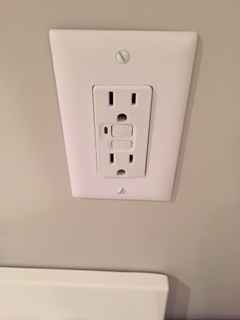
I read up on Arc Fault Circuit Interrupters and the AFCI testers as I have had no prior dealing or knowledge of this product. I just thought that they were another name for GFCI’s, Obviously I was wrong.
It is very good to know the differences with AFCI’s and GFCI’s. For instance, AFCIs are designed to detect small arcs of electricity before they have a chance to lead to a structure fire. While GFCIs are intended to prevent personal injury due to electric shock.
Advantages of Solar Energy
I found this very informative. I didn’t realize how many people are living off the grid. It states that as of 2006 there were 180,000 houses in the US. and 1.8 billion in the world. It also talks about the benefits to having solar power. Solar power is very reliable and especially good for areas that are prone ton rolling black outs. Benefits of solar power are low-emission, its suitable for remote areas, it provides green jobs, no moving parts, tax credits, conserves foreign dependent-ices, and it could pay you with net metering.
Aerogel
I have never heard of Aerogel before reading this article. Aerogel is a lightweight sold that is strong with a extremely high surface area. Aerogel appears to be blue and feels like Styrofoam. Its is a good insulator because it can combat conduction, convection and radiation. But its expensive to use, so at this time it is not widely used.
The electrical panel is a 200 amp Cutler-Hammer unit located in the attached garage on the east wall. The wiring appears in order and functioning properly. There are bushings present in the conduits which the wires are routed. The breakers are labeled on the door off the electrical panel.
Electrical panel with a 200amp service located at exterior rear of home
There was a proper ground source installed
Service drop was serviceable
Observations:
A dead/electrocuted rat was stuck along the breaker sides appearing to enter from the crawlspace through openings at back of panel.
Openings found
Recommendations:
Recommend further evaluation, removal of rat/debris and all necessary repairs by a qualified electrical contractor to eliminate any future intrusions
Starting the course now
I inspected the electrical panel and it looked good, so I traced the ground connections. The first picture is of the connections to the copper water pipes I found. This looked good and used #6 copper for the 150 amp panel. I then made sure the water pipes had the proper jumpers, which I show in the second picture. I then traced the green ground wire to see where the second source of grounding was at, but found that it went out of the house to be left dangling where an old satellite dish was hung. There was no second source of ground. I would recommend attaching the loose ground wire at the house exterior to an 8 foot grounding rod.
I read the article on AFCI testers. It was interesting to understand how they work. I was a bit confused though about whether to use them for testing at all since they are deemed unreliable to trip an AFCI breaker. Why not just push the test and reset buttons? But the article explained that you first want to use the indicator tool to test at the branch/outlet level. If you find a problem getting it to trip, then also try the test/reset buttons.
I also read the Aging In Place article. I can relate to this since I have 1 grandparent in a nursing home, and the other 2 living at home, all are over 90 years old. I liked all the suggested alterations to make living easier for the elderly at home, and have personally seen some bad conditions in the nursing home.
